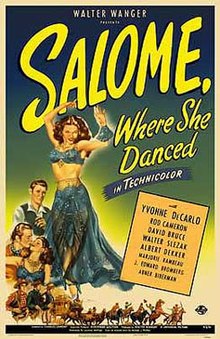
Susan Hayward was an Academy Award-winning American film actress, best known for her film portrayals of women that were based on true stories.

Joan Geraldine Bennett was an American stage, film, and television actress, one of three acting sisters from a show-business family. Beginning her career on the stage, Bennett appeared in more than 70 films from the era of silent films, well into the sound era. She is best remembered for her film noir femme fatale roles in director Fritz Lang's films—including Man Hunt (1941), The Woman in the Window (1944), and Scarlet Street (1945)—and for her television role as matriarch Elizabeth Collins Stoddard in the gothic 1960s soap opera Dark Shadows, for which she received an Emmy nomination in 1968.

María África Gracia Vidal, known professionally as Maria Montez, was a Dominican actress who gained fame and popularity in the 1940s starring in a series of filmed-in-Technicolor costume adventure films. Her screen image was that of a seductress, dressed in fanciful costumes and sparkling jewels. She became so identified with these adventure epics that she became known as The Queen of Technicolor. Over her career, Montez appeared in 26 films, 21 of which were made in North America, with the last five being made in Europe.

Margaret Yvonne Middleton, known professionally as Yvonne De Carlo, was a Canadian-American actress, dancer and singer. She became a Hollywood film star in the 1940s and 1950s, made several recordings, and later acted on television and stage.

The Captain's Paradise is a 1953 British comedy film produced and directed by Anthony Kimmins, and starring Alec Guinness, Yvonne De Carlo and Celia Johnson. Guinness plays the captain of a passenger ship that travels regularly between Gibraltar and Spanish Morocco. De Carlo plays his Moroccan wife and Johnson plays his British wife. The film begins at just before the end of the story, which is then told in a series of flashbacks.

Barbara Jane Bates was an American singer and actress, best known for her portrayal of Phoebe in the 1950 drama film All About Eve and as Katy Morgan on It's a Great Life (1954–1956).

Walter Wanger was an American film producer active from the 1910s, his career concluding with the turbulent production of Cleopatra, his last film, in 1963. He began at Paramount Pictures in the 1920s and eventually worked at virtually every major studio as either a contract producer or an independent. He also served as President of the Academy of Motion Picture Arts and Sciences from 1939 to October 1941 and from December 1941 to 1945. Strongly influenced by European films, Wanger developed a reputation as an intellectual and a socially conscious movie executive who produced provocative message movies and glittering romantic melodramas. He achieved notoriety when, in 1951, he shot and wounded the agent of his wife, Joan Bennett, because he suspected they were having an affair. He was convicted of the crime and served a four-month sentence, then returned to making movies.

Irene Maud Lentz, also known mononymously and professionally as Irene, was an American actress turned fashion designer and costume designer. Her work as a clothing designer in Los Angeles led to her career as a costume designer for films in the 1930s. Lentz also worked under the name Irene Gibbons.
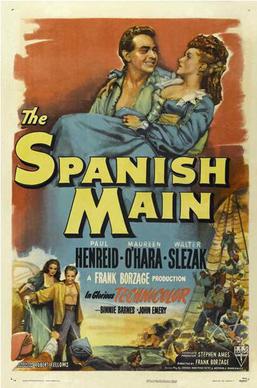
The Spanish Main is a 1945 American adventure film starring Paul Henreid, Maureen O'Hara, Walter Slezak and Binnie Barnes, and directed by Frank Borzage. It was RKO's first all-Technicolor film since Becky Sharp ten years before.
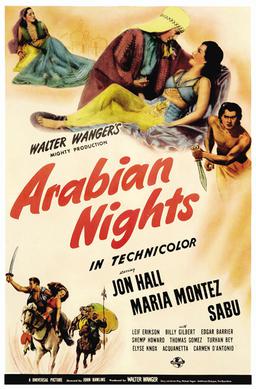
Arabian Nights is a 1942 adventure film directed by John Rawlins and starring Jon Hall, Maria Montez, Sabu and Leif Erikson. The film is derived from The Book of One Thousand and One Nights but owes more to the imagination of Universal Pictures than the original Arabian stories. Unlike other films in the genre, it features no monsters or supernatural elements.
Richard Ryen was a Hungarian-born actor who was expelled from Germany by the Nazis prior to World War II.
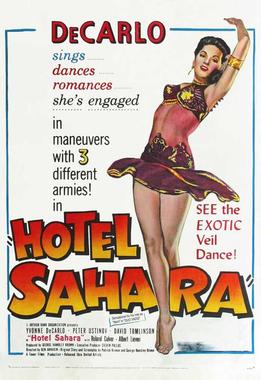
Hotel Sahara is a 1951 British war comedy film directed by Ken Annakin and starring Yvonne De Carlo, Peter Ustinov and David Tomlinson. It was produced and co-written by George Hambley Brown.

Sundown is a 1941 American black-and-white World War II film starring Gene Tierney, Bruce Cabot and George Sanders. It was directed by Henry Hathaway, produced by Jack Moss and Walter Wanger, written by Charles G. Booth and Barré Lyndon, and released by United Artists. Set in British East Africa, the film's adventure story was well received by critics, earning three Academy Award nominations, but it was a failure at the box office.

River Lady is a 1948 American lumberjack Western film directed by George Sherman and starring Yvonne De Carlo and Dan Duryea. It was filmed on the Universal Studios Backlot.

Song of Scheherazade is a 1947 American musical film directed by Walter Reisch. It tells the story of an imaginary episode in the life of the Russian composer Nikolai Rimsky-Korsakov, in 1865, when he was a young naval officer on shore leave in Morocco. It also features Yvonne De Carlo as a Spanish dancer named Cara de Talavera, Eve Arden as her mother, and Brian Donlevy as the ship's captain. Charles Kullman, a tenor with the Metropolitan Opera, plays the ship's doctor, Klin, who sings two of Rimsky-Korsakov's melodies.

Eagle Squadron is a 1942 American war film directed by Arthur Lubin and starring Robert Stack, Diana Barrymore, John Loder and Nigel Bruce. It was based on a story by C.S. Forester that appeared in Cosmopolitan magazine, and inspired by media reports of the fighting in the Battle of Britain, in particular, the American pilots who volunteered before the United States entered World War II, to fly for the Royal Air Force in the actual Eagle Squadrons.

This is the complete filmography of actress Yvonne De Carlo.
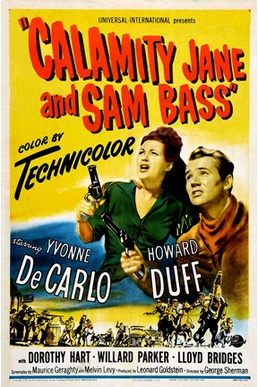
Calamity Jane and Sam Bass is a 1949 American Western film directed by George Sherman and starring Yvonne De Carlo, Howard Duff and Dorothy Hart.

Frontier Gal is a 1945 American Western film directed by Charles Lamont and starring Yvonne De Carlo and Rod Cameron.
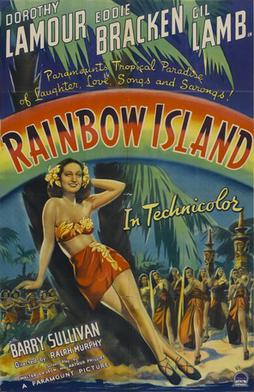
Rainbow Island is a 1944 American musical comedy film directed by Ralph Murphy and written by Arthur Phillips and Walter DeLeon. The film stars Dorothy Lamour, Eddie Bracken, Gil Lamb, Barry Sullivan, Forrest Orr, Anne Revere and Reed Hadley. The film was released on September 5, 1944, by Paramount Pictures.
